Parsley is considered one of the healthiest plants. The content in it of such vitamins as B1, B2, as well as carotene, potassium, magnesium and iron make it not only useful, but even medicinal. And in terms of vitamin C content, parsley is ahead of even citrus fruits. The best varieties of parsley will help grow a healthy seasoning that delights not only with an abundance of nutrients, but also with high yields. The editorial staff of the site "bestx.htgetrid.com/en/" offers you an overview of the best varieties of parsley for 2020.

Content
What is parsley good for?
Parsley is widely used in cooking. It is added to salads, meat and fish dishes, and is used for canning vegetables. This plant not only gives a piquant aroma to cooked products, saturates food with a delicate taste. It has a lot of useful medicinal properties that are effectively used in medicine and cosmetology. Most often, a decoction of parsley is made, because it retains a complex of vitamins and trace elements that have a therapeutic effect on the human body. Regular intake of the decoction helps to restore the whiteness of the tooth enamel, strengthen the walls of the kidneys and liver, and improve the functioning of the gastrointestinal tract. This is due to the herb's anti-inflammatory, antibacterial and diuretic properties. Therefore, the broth has a beneficial effect on the thyroid gland, urinary and genital and cardiovascular systems. Cosmetology with parsley helps get rid of acne, helps to smooth or whiten the skin, effectively relieves swelling.
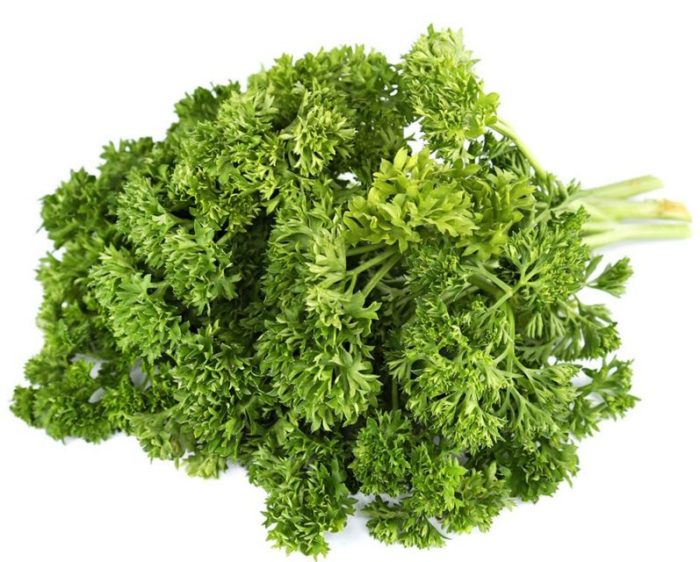
Benefits:
- relieves intoxication with alcohol poisoning;
- cleanses the body of toxic substances;
- used to prevent prostatitis;
- reduces the risk of heart attack;
- improves the general condition of the body;
- eliminates pain in women during the menstrual cycle;
- helps to eliminate freckles;
- helps to remove dandruff and cellulite;
- strengthens hair roots;
- improves bowel function;
- has a calming effect on the nervous system;
- helps to restore the level of hemoglobin;
- good for the eyes;
- has a healing effect on wounds;
- prophylactically used during the period of viral and colds;
- can be given to children.
Contraindications:
- you should take into account individual intolerance;
- give to children only after consulting a pediatrician;
- you can not abuse the broth: an excess of essential oil can cause discomfort;
- not recommended for pathological kidney diseases;
- use is prohibited for cystitis, urolithiasis, gout;
- contraindicated in people with low blood pressure;
- not for pregnant women, as well as nursing mothers;
- excessive consumption of broth of parsley can lead to dramatic weight loss.
In cases of contraindications to the use of parsley broth, it is better to use this product only in cooking.
Vitamins of parsley strengthen the immune system:
- The normalization of the liver and gastrointestinal tract is provided by folic acid.
- With the help of vitamin C, the nervous system is strengthened.
- Redox processes are regulated by a vitamin PP called nicotinic acid.
- Potassium metabolism is normalized by vitamin K.
- Capillaries are restored under the influence of vitamin E (tocopherol).
What varieties of parsley are grown in the garden?
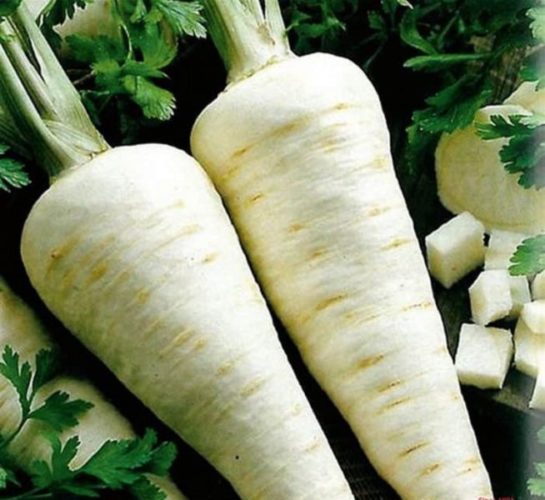
Fresh greens are constantly consumed by those who care about their health. In order to provide the family with a regular supply of vitamins, varieties are selected in accordance with the conditions: for greenhouses, open ground, growing using flowerpots, early ripening, mid-ripening, late.
In addition, parsley varieties also differ in external indicators. Allocate:
- common leaf parsley;
- curly parsley;
- root parsley.
Leafy varieties have tender, spicy, juicy leafy plates. They are used to decorate meat or fish dishes, make salads, add when canning tomatoes or cucumbers. Greens give a piquant taste, pleasant aroma, saturates food with a vitamin and mineral complex.
Curly greens have the same beneficial characteristics as leafy greens, but look more beautiful. That is why it is a frequent guest on the table on holidays. Another positive quality of curly parsley is its high frost resistance. It is suitable for freezing for the winter.
Root varietal varieties, giving the first year a rosette of fragrant leaves, form a white carrot root in the second year. This part of the plant is actively used in the preparation of marinades, soup or main courses. Root parsley is recommended by chefs as an expert in improving the taste of soup or salad. It keeps well frozen or dried. Even long-term storage does not prevent root crops from preserving useful consumer qualities.
Parsley is a biennial plant. In the first year, it forms a leaf rosette and a root crop, in the second year, a peduncle grows. Seeds ripen in the inflorescences, which can be sown on their own, giving a new crop the next year. The leaf and root plant are different in appearance. If a leaf culture develops a rosette of leaves, then in a root culture there are not very many leaves, since a root crop is formed. Selectors bred more than 60 varieties of leaf culture and about 20 root varieties. The popularity of greens is growing from year to year. Parsley is used not only as a food product, but also as a decorating plant.
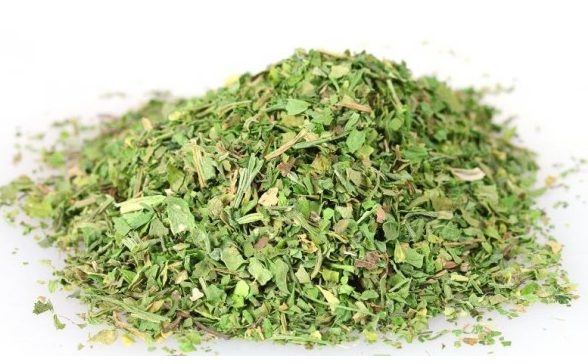
Rating of the best varieties of parsley
Common parsley
Beads
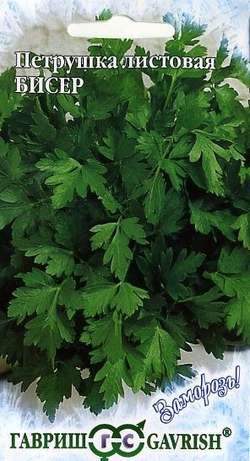
Russian manufacturer Gavrish. The Beads variety is early ripening, has a semi-raised rosette about 40 cm high. Ripens within 55-60 days. The leaves are of medium size, green tint, delicate fragrant smell. The plant is eaten fresh, but it is still perfect for freezing. The variety has a good yield, up to 2 kilograms. The average cost is 16 rubles.
Advantages:
- productive;
- delicate leaves;
- pleasant aroma;
- rapid maturation;
- suitable for freezing.
Disadvantages:
- rigid structure.
Bogatyr
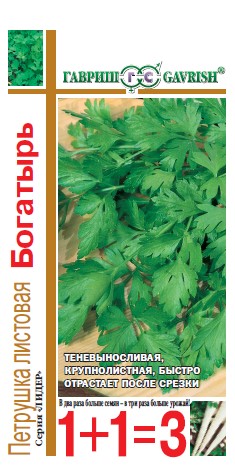
The seeds of this are produced in Russia. Late ripening variety. Recommended for fresh consumption. Suitable for growing in garden or vegetable gardens. The socket is half-raised. The plant has large leaves, rich green color. The hero can withstand the cold. Used in salads. The average cost is 25 rubles.
Advantages:
- high productivity;
- calmly tolerates shading;
- suitable for growing in a greenhouse;
- does not release peduncles;
- increases appetite;
- improves digestion.
Disadvantages:
- needs a sparse fit.
Ditty
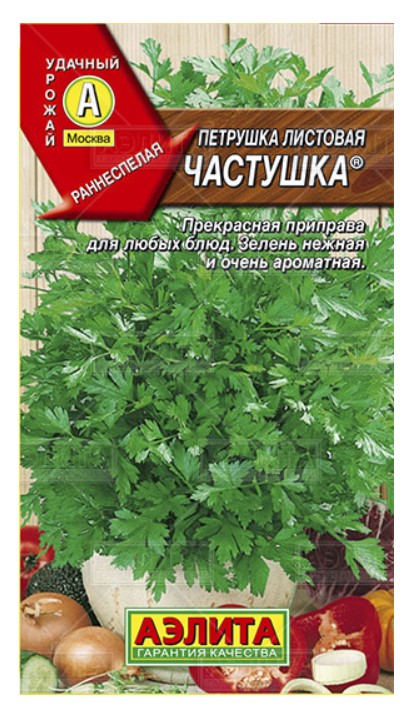
This type of domestic parsley is early, the ripening period is 60 days. The variety has a semi-vertical leaf rosette. The plant grows up to 40 cm, reaching a weight of 50 grams. Green leaves are used fresh in salads, as well as for canning. Regular watering, top dressing and loosening of the soil can achieve high yields.The average cost is 13 rubles.
Advantages:
- grows back quickly after cutting;
- has a pleasant spicy aroma;
- resistant to temperature extremes, including low;
- you can sow before winter;
- saturated with a vitamin complex;
- affordable.
Disadvantages:
- not found.
Nastya
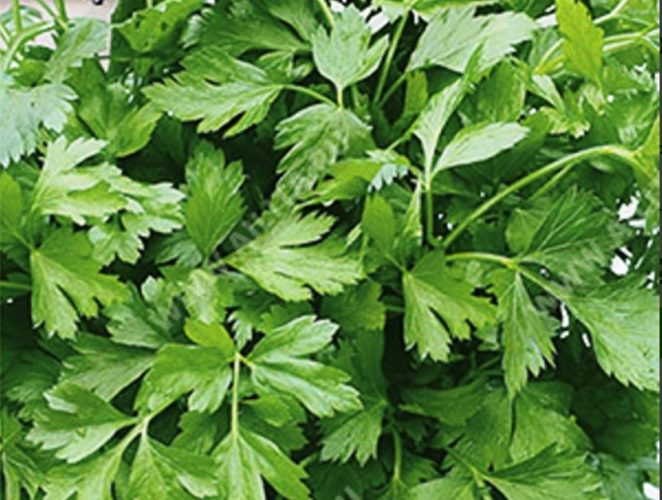
The seeds of the plant are produced in Russia. The variety has a patent. Popular for its early ripening and high yield. The leaf rosette is semi-vertical, reaching a height of up to 50 cm. The leaf plates are of medium size, triangular in shape. The average cost is 14 rubles.
Advantages:
- unpretentiousness;
- sweet and spicy taste;
- quick recovery after cutting;
- delicate aroma;
- affordable price.
Disadvantages:
- withers quickly after cutting.
Carnival
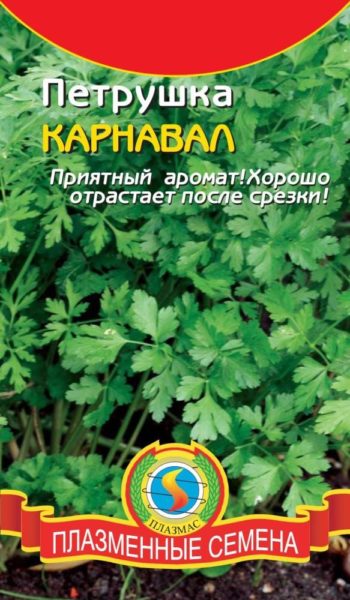
Produced in the Czech Republic. It is a mid-season vegetable, ripening period up to 90 days. The leaf rosette is formed from dark green plates and reaches medium height. The average cost is 20 rubles.
Advantages:
- high productivity;
- keeps the freshness of cut leaves for a long time;
- very fragrant smell;
- grows back quickly after cutting.
Disadvantages:
- leaves are rough;
- requires careful maintenance.
Breeze
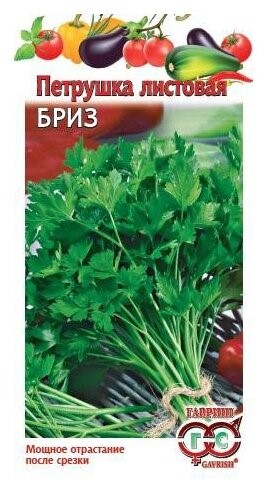
A mid-season variety offered by a domestic producer. Ripening period - up to 80 days. The height of the upright dark green leaf rosette is 75 centimeters. The cut rosette grows back quickly. Sowing is carried out in early spring or before winter. Parsley is a good seasoning for meat dishes. Used fresh or dried. Freezes well. The average cost is 13 rubles.
Advantages:
- has a high yield;
- frost-resistant;
- delicate taste;
- very fragrant when dried;
- affordable price.
Disadvantages:
- not found.
Festivalnaya
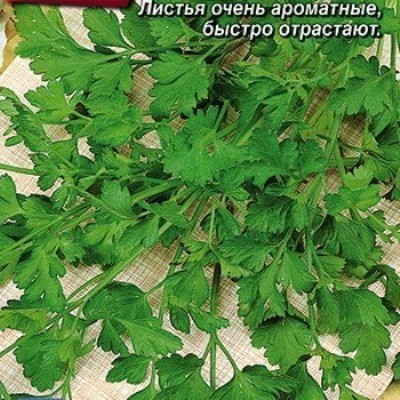
The variety has an early ripening period of about 60 days. The rosette grows developed, with up to 60 leaf plates of dark green color. Popular due to its resistance to low temperatures, as well as plant diseases. For a higher yield, the variety is recommended to be sown before winter. Greens are used fresh or dried. The seasoning gives dishes a rich taste, unsurpassed aroma. The average cost is 13 rubles.
Advantages:
- leaves are tender, having a pleasant taste;
- delicate spicy aroma;
- good germination;
- high content of essential oils;
- growing rapidly.
Disadvantages:
- abundant watering, top dressing is necessary.
Italian giant
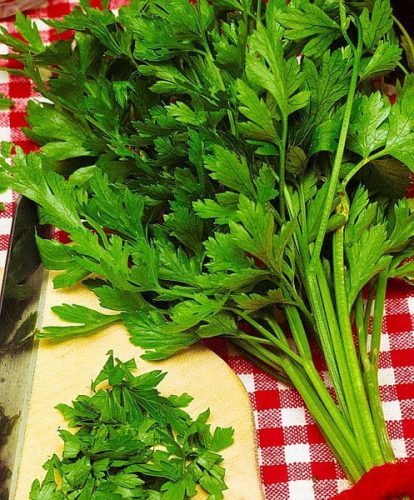
Plant with an average ripening period, maximum height 70 centimeters. The shape of the leaf plates is triangular. The green color lasts until autumn. The leaves, collected in powerful rosettes, reach a height of 70 centimeters. The plant is not afraid of the shade, it is resistant to diseases. Popular with culinary experts as a fragrant spice. The average cost is 4 rubles.
Advantages:
- high degree of aroma;
- leaves retain juiciness and tenderness for a long time;
- quick recovery after cutting;
- productive variety;
- low price.
Disadvantages:
- requires careful maintenance.
Curly parsley
Aster
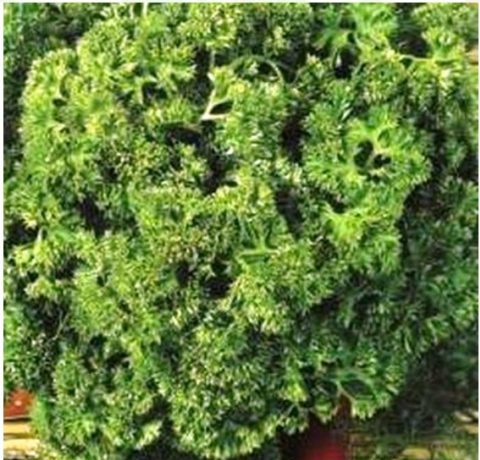
Early ripening variety, up to 60 days. Grown as a cooking spice or herb for sale. The rosette of leaves is semi-raised, dense, dense, formed from large corrugated dark green plates. The vegetable is suitable for growing both in greenhouse conditions and in an open area. Tolerates poor lighting. It retains freshness and presentation for a long time after cutting. The average cost is 15 rubles.
Advantages:
- gives 2-3 cuts per season;
- does not turn yellow for a long time and does not fade after cutting;
- has a very beautiful appearance;
- tender, juicy greens;
- often used for decorating dishes.
Disadvantages:
- needs fertilizing with nitrogen fertilizers.
Bravo
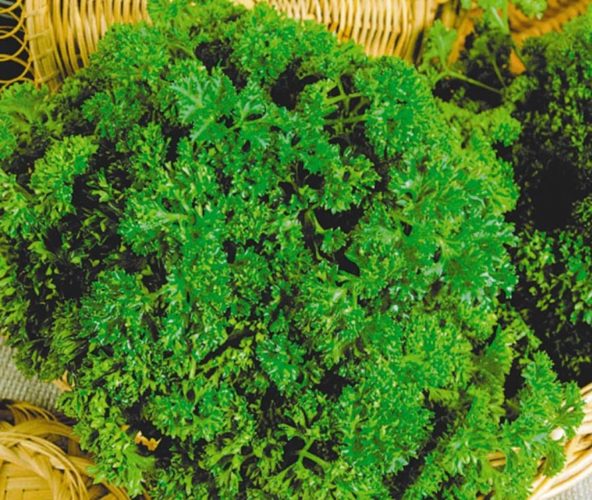
Domestic variety of early maturing seasoning. Ripens in 65 days. The rosettes are formed from highly corrugated sheet plates of bright saturated green. The plant is highly decorative. It grows well not only in a bright area, but also in a penumbra.Used mainly for decorating dishes. Contains a useful complex of vitamins. The average cost is 17 rubles.
Advantages:
- beautiful green color;
- unpretentiousness to conditions;
- quick recovery after cutting;
- delicate pleasant aroma;
- excellent taste.
Disadvantages:
- need to water abundantly.
Kucheryavets
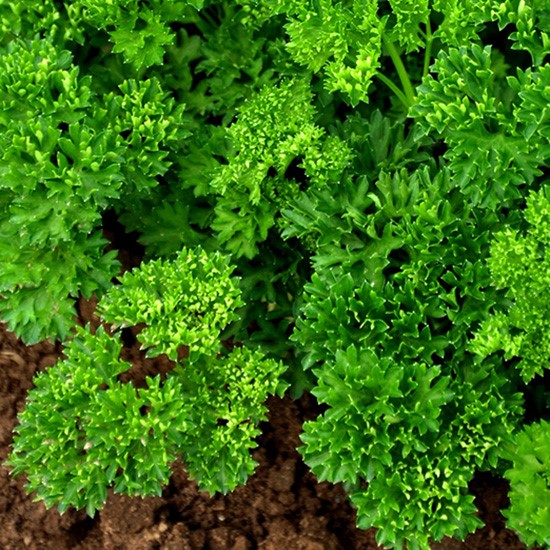
The variety is produced in Russia, has an average ripening period, a dense semi-vertical leaf rosette of rich green color. Recommended for growing in a vegetable garden or garden. The leaves are corrugated, the petiole is small. The average cost is 12 rubles.
Advantages:
- pleasant mild aroma;
- good productivity;
- long shelf life after cutting;
- short recovery process.
Disadvantages:
- requires careful maintenance.
Lace
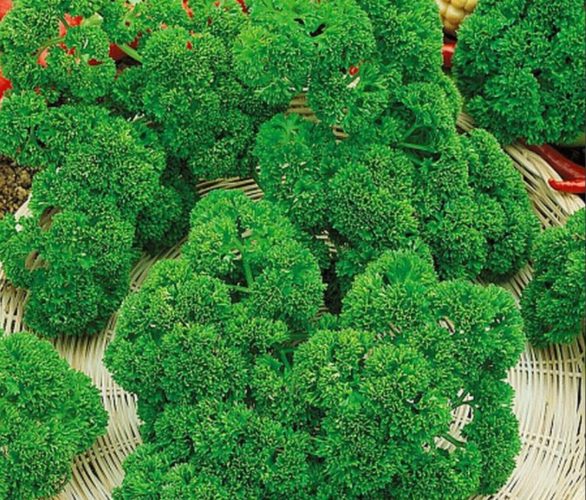
Russian variety of early ripening. Feels great both in the garden and in the garden. A rosette of corrugated leaves grows up to 25 cm in height. Thanks to the fast recovery process, it produces three cuts per season. The plant has a rich aromatic scent. The average cost is 15 rubles.
Advantages:
- shade-tolerant;
- compact;
- suitable for growing on the balcony;
- keeps a fresh look for a long time after cutting.
Disadvantages:
- requires regular watering, as well as feeding.
Root parsley
Alba
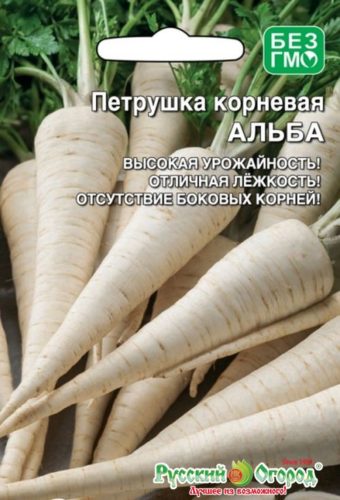
A variety with a late ripening period, up to 190 days. It tolerates winter well, in early spring it already gives the first greens. The root is conical, elongated, reaching a length of 25 cm. The leaf plates are green with gloss. The middle rosette is half-raised. The average cost is 3 rubles.
Advantages:
- high yield;
- keeps well in winter;
- has a pleasant spicy taste.
Disadvantages:
- demanding to care.
Sugar
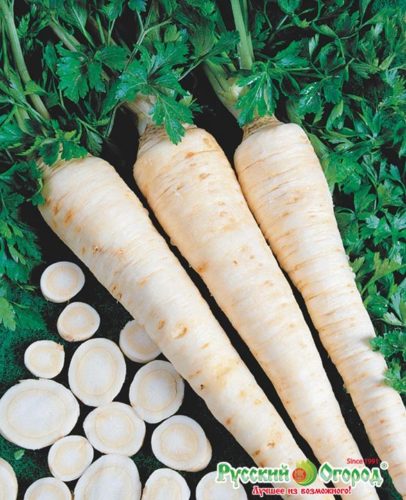
An early maturing variety that has established itself as unique. Both the root part and the leaf part are excellently eaten. But the constant cutting of the outlet is not recommended, this can damage the formation of the root crop. The cone-shaped root reaches a length of 30 cm and has a white flesh. The foliage is dark green, glossy, juicy. The average cost is 18 rubles.
Advantages:
- guaranteed high yield;
- pleasant spicy taste;
- versatility;
- early maturation.
Disadvantages:
- seedlings must be thinned out;
- plant in early spring.
Bordovician
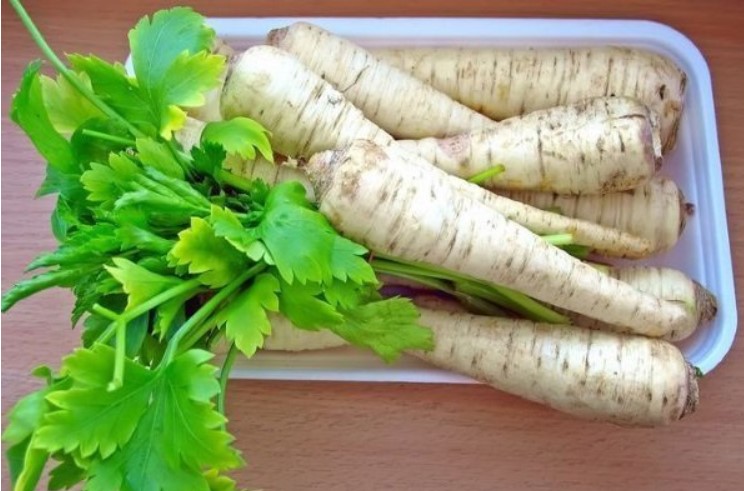
Medium ripeness variety, ripens in 130 days. Ideal for winter storage. The root vegetable is light in color, similar to carrots. Keeps well fresh. Greens have a dark green tint.
Advantages:
- frost resistance;
- the presence of a specific aroma;
- tender pulp of a ripe root.
Disadvantages:
- not found.
Gardeners and gardeners know many varieties of leaf or root parsley. The choice of seasoning depends on the consumer himself, on the purpose of the plant: obtaining a vitamin food supplement, a tasty ingredient in a salad, a decorative element of a festive table or garden plot. The best varieties of this cultivated plant will help not only to grow aromatic spicy greens, rich in vitamin and mineral complex, but also decorate dishes, add a spicy smell and piquant taste to them. If you have experience in growing parsley varieties described in the rating, or a more interesting variety, tell us about it in the comments.












